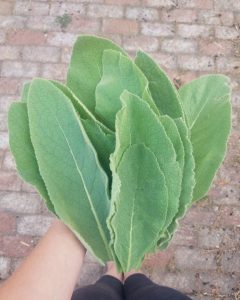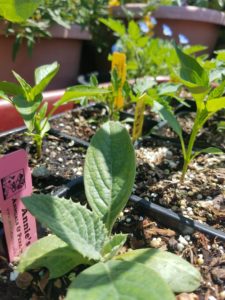Martinez News-Gazette Columnist

In light of the smoke-filled skies we’ve been experiencing in many parts of California, I decided to put this month’s column out a few days early to offer some herbal info related to the fires. These past few weeks have been a challenge: refinery fires, wildfires, evacuations, power outages, closed roads, air quality, and of course – the growing concern for what feels like the new normal in California this time of year. All these things combined to make for a physically and emotionally stressful couple of weeks.
Though herbs may not be a cure-all for the potential damage that smoke and trauma can have on our bodies and lives, there are certainly a handful of plants that I turn to whenever these unfortunate events take place. Below you can find my go-to herbal remedies for support during fire season.
Adaptogens
Adaptogens are a class of herbs that are thought to help the body better modulate stress. Fire season, especially with the addition of massive power outages, can be an extremely stressful time, and it’s in times like these that we can all probably use a lil’ extra help. The two adaptogens listed below are my favorites to use when there is smoke in the air.
Reishi (Ganoderma lucidum)
We briefly touched on Reishi mushroom in last month’s Hometown Herbalist column and it’s coming back for round two. Reishi is an adaptogen that has historically been used to help the body better modulate stress while simultaneously nourishing the immune system. Reishi has also traditionally been used to help support the bronchial system, making it one of my favorite choices for autumn and particularly for times like these. It can be made into a tea using dried slices or taken as a powder.
Tulsi (Ocimum tenuiflorum/Ocimum sanctum)
A lovely adaptogen that has historically been used to help calm the nervous system. Traditional use of this herb also includes protecting the body from toxin-induced damage and bronchial support. Tulsi can be taken as a tea and can be found in a variety of pre-made blends available at the grocery store. My favorite brands are Organic India and Traditional Medicinals.
Fire Tea
When the air outside gets smoky I immediately brew up a big batch of what I’ve started calling fire tea. This blend contains herbs that have traditionally been used to help boost the immune system, calm the nerves, support the respiratory and nervous systems, and protect the body from toxin-induced stress.
Ingredients
1-2 tablespoon dried elderberries
3-5 slices fresh ginger root
1 tablespoon tulsi leaf/flower
1 tablespoon mullein leaves
½ tablespoon thyme sprigs
Directions
Add elderberries and ginger to a small pot and cover with 5 cups of water. Bring to a simmer, cover partially, and cook on low heat for 20-30 minutes. Turn off the heat and add the tulsi, mullein, and thyme. Cover and steep for 10-15 minutes, then strain and enjoy.
I make sure to strain this blend extra well, as the fine hairs on mullein can irritate the throat. I use the finest mesh strainer that I have, which in my case is the same bag I use to make nut milk, but you can also use a coffee filter. You can find many of the herbs mentioned in this blend at Harvest House in Concord, Five Flavors Herbs in Oakland, or Herb Folk Community Medicine in Petaluma. You can also order them from Mountain Rose Herbs online.
Don’t have access to the herbs listed above? Peppermint and chamomile tea bags – which are available at most grocery stores – sweetened with a little honey, can go a long way as well.
Interested in learning more? Check back on the first Sunday of every month for the Hometown Herbalist column featuring local, seasonal, and regional botanical information.
Note: This information has not been evaluated by the FDA and is not intended to diagnose, treat, cure, or prevent any disease. This information should not be used as medical advice and is for educational, historical, and research purposes only. Always consult with your physician before adding herbal supplements into your diet, especially if you are pregnant, nursing, or on medication.
]]>Author Bio:
Anna Marie Beauchemin is a trained clinical herbalist, biologist, educator, and writer. Born and raised in Martinez, California she is passionate about sharing her craft with her community and helping people find balance and increased wellness in their lives. She offers private herbal consultations and herb-based workshops, locally. For more information visit her website at eastbayherbals.com or follow her on Facebook and Instagram @eastbayherbals
References Cited
Winston, David, and Steven Maimes. Adaptogens: Herbs for Strength, Stamina, and Stress
Relief. Healing Arts Press, 2019.
Rogers, Robert Dale. The Fungal Pharmacy: the Complete Guide to Medicinal Mushrooms and Lichens of North America. North Atlantic Books, 2011.
Cohen, Marcmaurice. “Tulsi – Ocimum Sanctum: A Herb for All Reasons.” Journal of Ayurveda and Integrative Medicine, vol. 5, no. 4, 2014, p. 251., doi:10.4103/0975-9476.146554.
Metzger, ByJane. “Creating a Local Materia Medica: Holy Basil.” Herbal Academy, 10 Jan. 2018, theherbalacademy.com/creating-local-materia-medica-holy-basil/.

By ANNA MARIE BEAUCHEMIN
Special to the Gazette
Of all the wonders that the herbal world bestows, my favorite medicine almost always comes in the form of tea. Putting the kettle on, choosing the herbs, waiting for the brew to complete, and finally – the settle in and sip. No matter how you lay it out, there’s just something magical about making yourself a cup of tea.
If you were paying attention in history class (wink, wink), you may remember that tea has actually been a pretty big part of many cultures (including our own) for a very long time. From traditional tea ceremonies to the afternoon cuppa – everyone in every place has their own unique way of doing tea, and of course, their favorite leaves to brew.
While many of us enjoy teas for their tastes and associated rituals, herbal teas are also an incredibly effective way to enjoy the medicinal properties of plants. So effective, in fact, that teas are one of the oldest forms of administering herbal medicine that there is. Dating back to the Shang dynasty the history of tea and its use as medicine is thousands of years old.
When we look at tea, it is really no surprise that these healing concoctions have been around for as long as they have. Making tea is easy, accessible, and can frequently be done with herbs and plants growing right outside your door. I like to think of tea as the gateway to herbal medicine – it’s relatable, it’s simple, and it’s generally pretty inexpensive. Whether you purchase pre-mixed tea bags at the store (my favorites are Traditional Medicinals and Organic India), or you buy loose leaf teas in bulk and create your own whimsical blends – making tea is easy and good for your health.
What’s better yet? There are endless ways to customize your tea to make it specific to your own needs. Feeling bloated after a big meal? Try some fennel, ginger, or orange peel. Feeling stressed? Bust out the chamomile. Agitated by the summer heat? Grab some mint or lemon verbena from the garden. Feeling blue over a recent breakup? Bring on the linden! No matter how you spin it, there’s almost always a tea to save the day.
One thing I should point out – and this may come as a shock – is that there is in fact, a right and a wrong way to make medicinal quality tea. Next time you go to brew up your favorite cup of herbal tea, try the method below and see if you notice a difference. By brewing tea the medicinal way, you ensure that your herbal blends will pack the biggest therapeutic punch that they can.
How To Make Tea The Medicinal Way
- Select the Tea: If you’re using loose leaf, you will want to use roughly one tablespoon per cup of water. Using a tea bag? Try two instead of one.
- Boil and Cover: After your kettle comes to a boil, turn the heat off, let it sit for a second, then pour the steamy hot water over your tea.
- Cover and Rest: Cover your cup with a small plate or bowl and let it sit for 10-20 minutes.
- Strain and Enjoy: Remove the tea bags or strain the loose leaves out – and voila!
- Think I am crazy for suggesting hot tea when it’s been in the 80’s? Make iced tea! Let your freshly brewed tea cool to room temperature and then store covered in the fridge for 1-2 days. Any herbal tea can quickly become an iced treat on a hot day!
Want to learn more about the magic of herbal iced teas and other refreshing botanical beverages? Check out my free workshop at Harvest House in Concord, on June 10th, 11:00 am – 12:00 pm!
Note: The information presented in this article is for educational purposes only. For more information about local, seasonal, herbal remedies and regional botanical information, check back on the first Sunday of every month for the Hometown Herbalist column.
Anna Marie Beauchemin is a trained Clinical Western Herbalist and Biologist. Born and raised in Martinez, California, she is passionate about sharing her craft with her community and helping people to find balance and wellness in their lives. She runs her practice in downtown Martinez – offering herbal consultations and custom formulations, herbal education, product development and consulting, and community herb walks. For more information about her services contact her at eastbayherbals@gmail.com or visit her website at eastbayherbals.com.
Main Story Photo Caption:
Chamomile from The Sonoma County Herb Exchange. Photo by Anna Beauchemin
Continuing into May gardeners all around will dust off their shovels and spades and start tending the earth below. We will make the trek to the local nursery to pick out fresh vegetable starts to line our garden beds with, and then the planting begins. Tomatoes, beans, peppers, corn – the cornucopia of plants that will adorn our yards this summer will start to make their way into the fertile spring ground.

While planting a good crop of delicious fruits and vegetables is an essential component of any family’s nutritional needs, let’s not forget about the unsung heroes of the garden – the herbs! Though many of us are likely planting things like basil, oregano, and rosemary, what we may not realize is that most of the culinary herbs we’re planting are actually medicinal herbs.
People often think of medicinal plants as being unknown entities from a far-off land. In reality, however, many of the herbs used in herbal medicine meet halfway between the medicinal and culinary worlds. Medicinal plants are often dualistic in nature, and it is this duality that makes them an ideal choice for someone who is interested in learning more about herbalism. By adding herbs into your garden you can elevate your gardening game, incorporating a new level of health and wellness into your home.
Herbs like thyme, oregano, basil, sage, and rosemary not only have a distinct flavor that makes them a great addition to any summer dish but a myriad of medicinal properties as well. Medicinal flowers like calendula, borage, chamomile, and violet can add both beauty to the landscape and elegance to seasonal salads and desserts. For those of you who enjoy growing your own fruit, berries like elderberry and raspberry (though we use the leaf of raspberry, not the berry) offer potent medicine as well. The rinds of California’s prized citrus, like orange and lemon, can be used as a flavorful and medicinal component to many teas.
What’s better yet? Many of the herbs listed above do great in planters and pots, making them an option for someone with little to no backyard space. While having an urban farm may be the dream (ok, at least mine) you don’t have to have a big garden to plant medicinal herbs. When it comes to some of nature’s most giving plants a simple windowsill or porch will do the trick!
One of the things I love so much about herbalism is its versatility. Just as the food we put into our bodies acts as medicine, the herbs we add to our dishes do the same. From the fresh homegrown tomato to the robust patch of thyme that pours out of a planter on your porch, turning your food into medicine is a practice that brings vibrancy to the yard and added health to you and those that you love. This year, when you’re planning your garden, make sure to save a little space for some of the many medicinal plants mentioned above.
Interested in learning more about planning a medicinal herb garden? Join me for a FREE community workshop at Harvest House in Concord on Saturday, May 19th from 11:00 am-12:00 pm. We will be going in depth about what herbs to plant in your yard and how they can be used, as well as talking about plants that are beneficial to pollinators.
Note: For more information about local, seasonal, herbal remedies and regional botanical information, check back on the first Sunday of every month for the Hometown Herbalist column.
]]>
Anna Marie Beauchemin is a trained Clinical Western Herbalist and Biologist. Born and raised in Martinez, California, she is passionate about sharing her craft with her community and helping people to find balance and wellness in their lives. She runs her practice in downtown Martinez – offering herbal consultations and custom formulations, herbal education, product development and consulting, and community herb walks. For more information about her services contact her at eastbayherbals@gmail.com or visit her website at eastbayherbals.com.
Special to the Gazette
When I was growing up, my mom had a plethora of remedies that she would use with me whenever I got sick. She had a kitchen cabinet full of herbs and spices, and a pantry full of food that she somehow seemed to magically weave together, into something that usually left me feeling better than I did before. She was my go-to practitioner for most of my life. No matter what the ailment was (granted, I have been fortunate with good health in my 33-years on this earth), she always seemed to have something up her sleeve that would help. We had a garden in the backyard that provided us with homegrown fruits and vegetables, and chickens in the coop that gave us fresh eggs. We were surrounded by the natural beauty and plants of the Alhambra Valley.

The roots of our country’s medicine are not so different from the tale I told above. From the family caregiver, to the community doctor, to the indigenous healers that came before us, the roots of medicine in the United States, and the rest of the world are based on very similar principles – using the plants and foods around you to heal that which ails you.
In California, there are a lot (and I mean a lot) of plants that grow here and that are extremely beneficial to our health and well-being. From the weeds that grow in our backyards, to the majestic Bay Laurel trees in the Carquinez hills, we are surrounded by plants with medicinal properties. The therapeutic use of these plants is called herbal medicine.
With a 5000-year history of being used by people around the world, [1] the practice of using plants as medicine is a long-standing tradition across the globe. Flash forward to the present day, and the field of herbalism continues to grow and change to meet the needs of the modern person. In addition to a rich oral and written history supported by anecdotal evidence, herbal medicine is now studied at the clinical level as well. Due to the advancements in modern science, we can now pick a plant apart, isolate the exact phytochemicals within that plant that lead to its healing properties, and look at how those properties affect a person’s physiology and health.
We are fortunate in the United States to have a well-established modern medicine system which saves countless lives on a daily basis. Advancements in western medicine have allowed people to live longer – an opportunity that was not always available in previous times. Contemporary medicine is an incredible thing, and I think because of this many people assume that the choice is one or the other; do I go the natural route, or do I go the doctor instead?
Luckily, living in this world right now, we have the option to choose both. We can utilize the traditions of those who came before us while simultaneously benefiting from the innovations of modern medicine. When used as a compliment to your regular healthcare practice, these two approaches to wellness have a tremendous opportunity to heal.
Why herbs? Because that’s what people have been doing since the beginning of time, and lucky for us, they’re everywhere!
Note: For more information about local, seasonal, herbal remedies and regional botanical information, check back on the first Sunday of every month. Want to learn more and can’t wait? I will be teaching a free workshop on Herbalism at Harvest House in Concord on April 15th from 11:00-12:00.
Anna Marie Beauchemin is a trained Clinical Western Herbalist and Biologist. Born and raised in Martinez, California, she is passionate about sharing her craft with her community and helping people to find balance and wellness in their lives. She runs her practice in downtown Martinez – offering herbal consultations and custom formulations, herbal education, product development and consulting, and community herb walks. For more information about her services contact her at eastbayherbals@gmail.com.
[1] Herbal Medicine Fundamentals. (2016, November 13). Retrieved March 24, 2018, from https://www.americanherbalistsguild.com/herbal-medicine-fundamentals
]]>